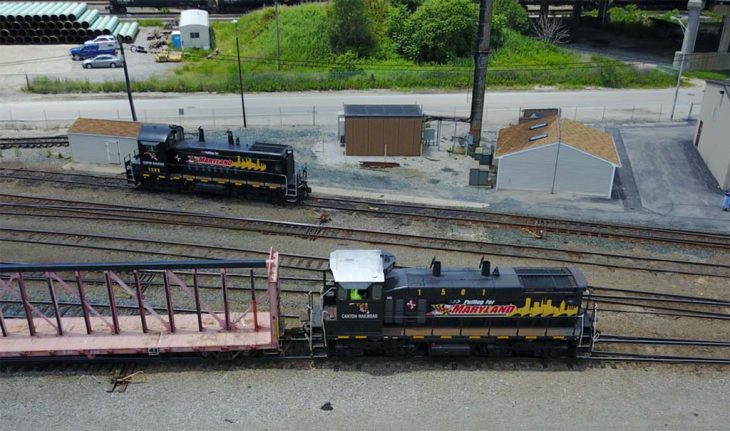
Railfanning the Canton Railroad with a Drone
By John Stralka
(Reprinted and slightly edited from The Relay, 2017, Volume 7, Issue 3)
On Friday June 9th, 2017 the Canton Railroad in Baltimore, MD hosted a group of NMRA members from the Chesapeake Division for a tour of their headquarters and adjacent Penn-Mary Yard. I would like to thank Rick Uskert, Assistant Superintendent of the Chesapeake Division, for arranging this rare opportunity. With the heightened security in the post-9/11 era, it is not often that modelers and railfans can get such phenomenal access to an operating railroad in a major city!
Our tour started off with an introduction to the railroad, along with a discussion of its history and operations, given by the Canton Railroad’s President and CEO John Magness. He was extremely knowledgeable and was an engaging speaker. After a question and answer session, Rail Coordinator Tyler Horner took the group for a tour of Penn-Mary Yard. Tyler also provided a great deal of information about the day-to-day operations of the railroad. The group was able to capture some great photographs because it was a gorgeous day.
After the tour was over, I inquired about the possibility of taking some aerial railfan shots from my recently acquired DJI Mavic Pro quadcopter drone. I was fully prepared for a negative reaction, but, to my pleasant surprise, John and Tyler approved my request! With my friends and fellow modelers Jim Beuchel and Gary Boardley, we set up a base of flight operations right outside the yard office and got the drone airborne.
The recently released DJI Mavic Pro is an incredible piece of technology. It comes from the relatively long legacy of the DJI Phantom line, which are somewhat high-end, ready-to-fly hobbyist quadcopters meant for taking aerial photographs and videos. The best feature of the Mavic Pro is that it can be easily folded up into a compact package for convenient transport and storage. The gimbal-stabilized 12 megapixel camera is capable of shooting 4k videos at 24 frames per second). The handheld wireless controller has a display for crucial flight parameters, while the camera is controlled by an attached smart phone, which also displays the drone camera’s field-of-view. The drone is extremely easy to fly and provides a rock-solid base for photography even when buffeted by wind gusts. I get about 20 minutes of flying time for a single battery. I typically land before the battery has less than 33% of charge left. I had three batteries on hand for this outing. I’m still learning how to use this system, but have found that most of the work is in operating the camera. While flying drones is easy, I recommend having a friend with you as a “copilot” to monitor the surroundings while you are focused on operating the drone. While the requirement to register hobbyist drones with the FAA has been lifted, you still have to follow airspace rules. You should also fly safely with common sense and be respectful of others.
I was able to capture footage of several Canton Railroad trains coming back into Penn-Mary Yard with cuts of freight cars. A CSX intermodal freight also passed through the yard via trackage rights to get to Seagirt Marine Terminal.
Some of the aerial videos captured were posted on YouTube for your viewing pleasure:
- “Baltimore, MD – Canton Railroad #1203 Entering Penn-Mary Yard”
- “Baltimore, MD – CSX Intermodal Freight Passing Through Penn-Mary Yard”
- “Baltimore, MD – Canton Railroad #1501 Entering Penn-Mary Yard”
Railfanning with drones is a great way to get an interesting perspective of real railroads. This perspective mimics the viewpoint we typically have with model railroads. As a result, drone-based photography allows a modeler the means to capture the essence of prototype railroad scenes in order to more faithfully recreate them in miniature.